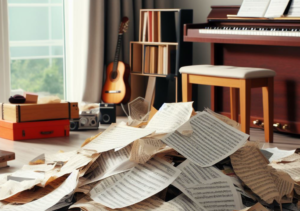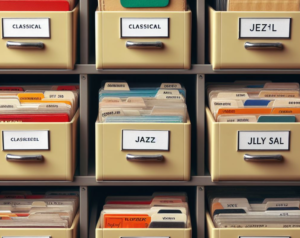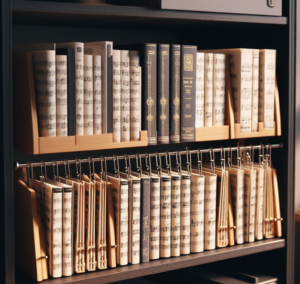The Complete Guide to Organizing Your Sheet Music Library

Are you feeling overwhelmed by the piles of sheet music scattered around your home? Do you struggle to quickly find the pieces you need for lessons or performances? Getting your sheet music collection organized can feel like an impossible task.
This guide will provide solutions to tame the sheet music clutter and establish an efficient storage and filing system. We'll cover:
- The best storage furniture like shelves and file cabinets
- Helpful organizing accessories including binders, dividers, and labels
- Digitizing and scanning apps to create digital sheet music
- Categorization methods to group your music by composer, genre, instrument, and more
- Special tips for different instrument types
- Protecting and preserving your sheet music
- Our top product recommendations for sheet music storage
With these practical tips, you'll be able to create order from the chaos. A well-organized sheet music library will make your life as a musician or teacher much easier!
[lwptoc float="left"]
Get Your Sheet Music in Shape with Storage Solutions
Is your sheet music collection starting to resemble a crazy game of 52 Pickup? Do you keep buying more music books only to shove them onto an already teetering pile? We've all been there! Getting your sheet music sorted into a real storage system can feel overwhelming but trust me, it's so worth it.
Let's look at some of the best options for taming the sheet music clutter:
File Cabinets - Store Your Music Vertically
File cabinets are a classic storage solution for a reason. Those vertical drawers keep your sheet music neatly organized and easy to flip through. I like to think of each drawer as a category, with hanging folders inside for subgroups.

Pro Tip: Invest in some hanging folders with tabs to create labels. Use a label maker to mark them with categories like "Classical," "Jazz," "Holiday," etc.
Some file cabinet tips:
- Look for wider, legal-size drawers to easily fit sheet music. The standard letter size can be too narrow.
- If space is tight, consider lateral filing cabinets that slide side-to-side rather than opening out.
- Add some drawer dividers for adjustment - you may need higher rows for orchestra scores.
- Metal cabinets are best for protecting your music collection long-term.
Shelve It - Store Your Music Horizontally
Shelving units like bookcases offer another excellent option for organizing sheet music. Arrange your music neatly on the shelves for quick browsing when you need a certain piece.

Some tips for shelving:
- Sturdy wooden shelves prevent sagging in the middle, which can damage your sheet music.
- Bookends are a must for keeping your music upright and in pristine condition.
- For ease of scanning, store music in magazine files labeled with categories.
- Adjustable shelves allow you to customize the height. Make the rows fit your collection.
- Add doors to closed shelving units if you prefer the neat, hidden look.
Specialty Storage for Quick Access
For the sheet music you use frequently, specialty storage can save you rummaging time:
- Piano benches with interior storage compartments organize the music you need at lessons.
- Music stands like choir flip folders keep vocal pieces handy at practice.
- A rolling music cart can be transported to gigs and performances.
Get creative and use storage that fits your musical needs! Just remember to handle that precious sheet music gently.
Accessorize Your Sheet Music Storage
Alright, you've got the furniture—it's time to accessorize your sheet music storage! Those special tools and supplies will take your organization to the next level.
Let's look at the best accessories for taming your music library:
Binders - The Portable Sheet Music Holder
Stash your sheet music in binders to create easily transportable collections. Just slip in some sheet protectors first to save those pages from rips and tears. Some tips:
- 3-ring binders allow you to organize and remove sheet music with hole punches.
- Choose wider binders sized for sheet music, not standard letter paper.
- Use tabbed dividers marked with categories like "Bach Inventions" or "Choir Songs".
- Zippered binders keep loose pages secure if you're on the go.
Magazine Files - Subdivide Your Shelves
Magazine files are a simple and affordable way to organize music into sections on your shelves. Pro tips:
- Label each magazine file using a label maker - composers, music styles, etc.
- Choose different colored files to color code your sheet music types.
- Face the labeled spines outwards for easy scanning.
- Stand magazine files upright like books - no more sliding pages!
Bookends - Keep Your Music Upright and Orderly
Unless you want a crooked, wrinkled mess, bookends are non-negotiable for any shelves storing sheet music.
- Weighty metal or acrylic bookends stay firmly in place.
- Adjustable bookends secure varying widths of music books.
- Use bookends in pairs to keep individual sections tidy.
Labels – Your Organizational Tools
Don't underestimate the power of labels for keeping your music collection orderly!
- Adhere color-coded labels on binders, folders, shelves and more.
- Invest in a label maker to print professional labels for categories.
- Use washi tape, stickers, and handwritten labels for a personal touch.
Bring Your Sheet Music Collection to the Digital Age
As much as we love the look and feel of physical sheet music, let's talk about the benefits of digitizing your collection.
Scanning apps allow you to capture your sheet music as digital files. This opens up a whole new world of convenience!
Benefits of digital sheet music:
- Access your music library from any device instantly - phone, tablet, computer, etc.
- Easy to organize and search for digitized sheet music on your devices.
- No more fumbling with pages turning - swipe easily on your iPad.
- Share sheet music easily with students and colleagues.
- Save physical storage space - reduce your sheet music clutter!
Recommended scanning apps:
- ScanScore - specifically designed for sheet music digitizing. Has editing tools.
- Adobe Scan - uses your phone camera for quick digitizing into PDFs.
- CamScanner - scans documents easily into sharable digital files.
Once scanned, store your new digital sheet music collection on cloud storage platforms like Google Drive or Dropbox. And enjoy the convenience of an organized, searchable music library anywhere!
Get Organized: Categorization Methods for Your Sheet Music
Now for the fun part - figuring out how to categorize all that sheet music! Organizing your music collection into a system that makes sense for YOU is key.
Let's explore some common methods:
By Composer
Grouping your sheet music by composer works well if you have lots of music from the same writers.
- On shelves, keep all music by Bach together, then Mozart, etc.
- In file cabinets, give each composer their own hanging folder.
- Use alphabetical order to easily locate composers.
By Musical Style/Genre
Categorizing by musical styles like Classical, Jazz, Pop, etc. makes sense if your music taste is eclectic.
- Give each genre its own space on your shelves or file drawer.
- Use genre labels on binders and dividers to identify categories clearly.
By Instrument
For you musicians, organizing by instrument helps gather all your sheet music for practicing.
- Pianists - have sections for Piano Solo, Piano Duets, Piano Accompaniments, etc.
- Singers - separate your Vocal Solos, Choral Pieces, Lieder, Opera, etc.
- Guitarists - group your Guitar Methods, Etudes, Classical Repertoire, Tab Books, and more.
By Skill Level
If you're a teacher, categorizing your sheet music by skill level helps assign appropriate pieces to students.
- Levels like "Beginner", "Intermediate", "Advanced"
- Group method books into progressive levels.
- Sort repertoire by graded systems (with numerals, letters, descriptive levels).
The Hybrid Approach
For larger collections, a hybrid system using multiple categories works best. Some ideas:
- Group by instrument, then sub-categorize by composer and level.
- On your shelves, divide by genre, then use colored labels to indicate skill level within each section.
- In binders, use tabbed dividers to first separate by instrument, then by repertoire type for each instrument.
Get creative and find a hybrid solution tailored to your unique music library!
Tailor Your Storage to Specific Instruments
Alright musicians, we all know that organizing sheet music looks a bit different for each instrument. Your storage solutions should match how you practice and perform!
Let's look at some instrument-specific tips:
Piano Music Storage
As a pianist, your sheet music collection is likely massive. Some pointers:
- Store in file cabinets - the deep drawers have ample room for your repertoire.
- Add rolling shelves that pull out for easy access to your piano music.
- Keep frequently played pieces in your piano bench or a music stand.
- Arrange by composer then skill level - you'll have lots of both!
Vocalist Sheet Music Storage
Singers, keep your vocal solos, choral songs, and accompaniment music organized:
- Binders allow you to arrange vocal sheet music for practice or performance.
- Use dividers or tabs to find selections quickly for rehearsal.
- Store collections by voice type - soprano, alto, tenor, bass.
- Keep a music stand nearby to hold your vocal music.
Orchestra & Band Music Storage
Large ensemble and orchestral music can be tricky. Consider:
- Wide flat filing cabinets to accommodate oversize conductor scores.
- Sturdy shelving that won't buckle under heavy sheet music volumes.
- Sort instrumental parts into labeled boxes by section - woodwinds, brass, percussion.
Special Considerations for Your Sheet Music Storage
We've covered a lot of bases, but let's chat about some special situations that affect sheet music organization:
Student vs Personal Collections
As a teacher, you may want to separate your sheet music from your students' assigned books.
- Store your personal music library separately from student books.
- Use labels like "Teacher Copy" and "Student Copy" to differentiate.
- Keep student books handy on open shelving for easy distribution.
Multiple Storage Locations
Many musicians have sheet music in different places - take inventory!
- Note what's at home, your studio, the rehearsal hall, etc.
- Catalog your entire music collection across locations.
- Consider consolidating some pieces to your primary storage.
Quick Access to Frequently Used Music
Keep your most used sheet music close at hand:
- In your piano bench, on an easily reachable shelf, or in a handy binder.
- Avoid stashing frequently played pieces in storage you rarely access.
Handle with Care: Protecting Your Sheet Music Investment
Sheet music can be a prized treasure - follow these tips to preserve those pages for years to come!
- Handle sheet music gently to avoid rips, wrinkles, and folds. Don't wad it up!
- Consider wearing clean cotton gloves when handling very old or delicate music. The oils on your hands can deteriorate the paper.
- Store sheet music flat when possible, or fully supported upright. Leaning books get warped and damaged over time.
- Shelve music in a cool, dry place away from sunlight, moisture, and humidity. All can cause decay.
- Inspect regularly for signs of deterioration like yellowing, brittleness, foxing spots, or tears. Catch issues early.
- Clean dust gently with a soft cloth - don't use chemical cleaners.
- Avoid writing or marking originals if possible. Use pencil lightly if needed.
- Scan or photocopy fragile manuscripts to preserve the originals.
- Sleeve loose pages in archival plastic for added protection.
- Repair minor damage with acid-free mending tape before it worsens.
- Consider investing in archival boxes, folders, envelopes, and albums made from inert materials. Look for "acid-free" or "lignin-free".
- Have valuable sheet music professionally restored if needed.
Like any collection, your sheet music requires care and maintenance for longevity. But a few simple habits will keep it in great shape for years of music-making!
Shopping for Sheet Music Storage
Ready to shop for storage solutions? Here are my top recommended products to organize your sheet music collection:
- Sturdy wooden bookshelves like the 4-shelf unit from Target.
- Metal lateral file cabinets with smooth, full-extension drawers like the Sandusky series.
- Adjustable drawer dividers for custom organization like these clear insert trays from Amazon.
- Archival quality sheet protectors and binders like the Hollinger Line brand.
- Label makers for professional looking labels - try the Brother P-Touch Cube Plus.
- Piano benches with built-in storage like the adjustable Artist bench from OnStage.
- Music stand with carrying case like the clever Stagg EKG system.
- Acid-free archival boxes and folders from university library suppliers like Gaylord.
Check the links above for my top picks to keep your sheet music neatly organized and protected for years to come. Happy music storage shopping!
Your Sheet Music Storage Questions, Answered!
Let's wrap up with some frequently asked questions about organizing sheet music:
How do I prevent sheet music damage on shelves?
- Use sturdy bookends to keep music upright.
- Store in protective boxes or files - don't let pages slide around.
- Keep away from direct sunlight and moisture.
What are the best binders for sheet music storage?
- Opt for wide 3-ring binders sized for sheet music, not standard binders.
- Use soft cloth binders, not stiff boards that could bend pages.
- Slip pages into archival sheet protectors to prevent rips.
Should I organize my music collection by composer or skill level?
- Consider your needs - do you search by composer more, or need to find beginner pieces quickly?
- Use a hybrid approach with levels of organization - composers within skill levels, etc.
What provides the most space efficient sheet music storage?
- File cabinets with hanging folders maximize vertical storage.
- Deep shelves arranged neatly can also fit a lot of music.
- Condense with boxes and binders to save space.
How to Become a Successful Busker: A Beginner's Guide
Learn how to start your busking career with our comprehensive guide. Discover tips on choosing locations, building a repertoire, and engaging audiences for successful street performances.
Mastering the C Major Scale on Piano
Learn to play the C Major scale on piano effortlessly. Our detailed guide covers finger positioning, practice techniques, and tips for smooth execution of this fundamental scale.
Understanding the Treble Clef: What it is and How to Read it
Demystify the treble clef with our easy-to-follow guide. Learn its purpose, how to read notes, and practice tips to improve your music reading skills for piano and other instruments.
How to Become a Successful Busker: A Beginner's Guide
Learn how to start your busking career with our comprehensive guide. Discover tips on choosing locations, building a repertoire, and engaging audiences for successful street performances.
Mastering the C Major Scale on Piano
Learn to play the C Major scale on piano effortlessly. Our detailed guide covers finger positioning, practice techniques, and tips for smooth execution of this fundamental scale.
Understanding the Treble Clef: What it is and How to Read it
Demystify the treble clef with our easy-to-follow guide. Learn its purpose, how to read notes, and practice tips to improve your music reading skills for piano and other instruments.
Unleashing the Soulful Power of Chords in the Key of A Minor
Explore the emotive power of A minor chords. Our guide teaches you to build, play, and incorporate these chords into your piano playing for more expressive performances.